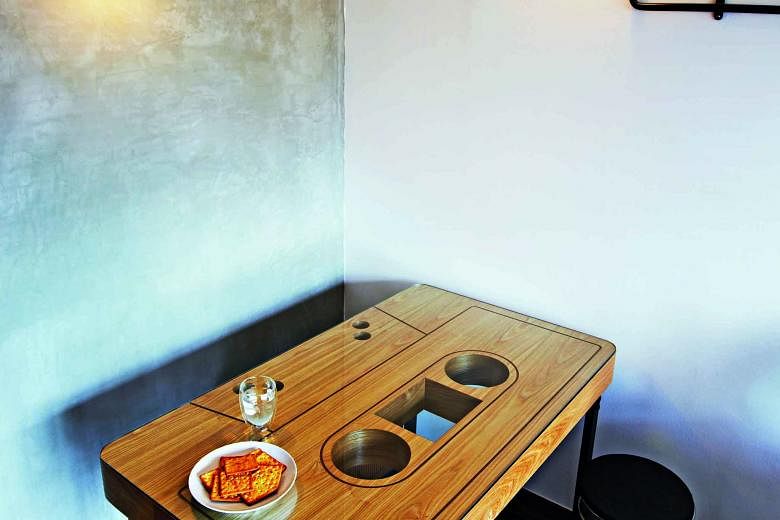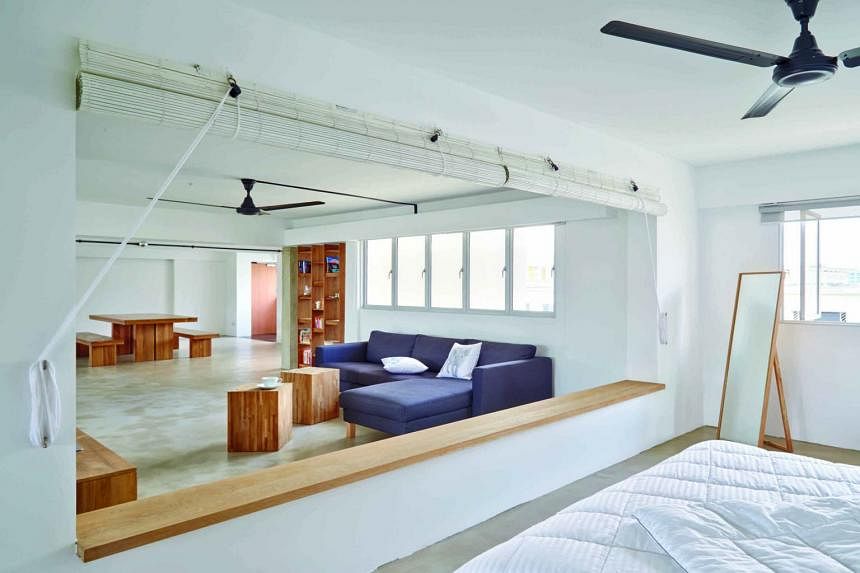Custom-make your own furniture for unique style
It would be nice to design my own furniture and get someone to build it, but will it end up costing much more than what is available in shops?
It is an additional source of pride for home owners to say they designed the furniture in their home.
Depending on the materials used and the construction methods, creating your own bespoke furniture could save you money.
Mr Kelvin Teo of interior design firm Space Sense says the most commonly requested pieces he is asked to design and build are dining tables, benches and bookshelves.
"I don't get asked to do sofas, as people usually want to try the sofa before they buy," he says.
According to him, a customised dining table can cost as little as $1,500. For this price, he has built one with metal legs and a homogeneous tile surface which looks like wood. "The tile had a realistic texture, is waterproof and resistant to scratches as well, unlike real wood," he recalls.
He has also built unique designs, such as a table resembling an aeroplane wing, which cost $3,600. It was wrapped with an aluminium plate, riveted and, with an I-beam as the leg, connected to a metal base.
Bookshelves can cost between $2,000 and $3,200. Customised furniture can be done in a month or two.
To save money, clients sometimes ask Mr Teo to replicate the look of furniture they see in shops. "I can recreate the look but because we can't get the same material, it won't look exactly like the original, although it might be cheaper," he explains.
Moulded plastic furniture and other pieces that require specialised equipment cannot be made either, he adds.
Get certification for wood products
Is wood furniture eco-friendly?
The process of making any piece of furniture uses up resources from the environment, whether it is made of wood, metal or plastic.
Trees reduce the carbon dioxide in the air, contribute to the water cycle and maintain biodiversity in forests.
But the management of wood resources is regulated in some countries so that the wood is sustainable, meaning that the material is renewable, can be easily found and replaced. Trees that come from plantations are replanted once they are felled.
If you are concerned about where the wood used for a piece of furniture is from, ask the seller.
Look for certifications from organisations such as the Forest Stewardship Council (FSC), which operates in more than 80 countries; or the international non-profit, non-government group Programme for the Endorsement of Forest Certification (PEFC). Both are watchdogs for responsible forestry management practices.
Beyond the label, buy good-quality designs that will stand the test of time - pieces made of one kind of wood and from countries with established certification practices, such as the United States and Indonesia.
Some wood, such as rubber wood, are also sustainable as they are by-products of another industry.
Locally, you can get certified as well as repurposed- wood furniture from shops such as Mountain Teak, Journey East and Ethnicraft.
Falling costs of solar panel systems
Solar panels have been around for a while. Are they cheaper now? What do I need to take note of before installing them?
Seeing that it is going to get only hotter in Singapore, getting a solar photovoltaic (PV) system for your house, which converts sunlight into electricity, is a smart move and will save you money in the long run.
The initial investment may be high, but the cost of such systems has been falling by about 4 per cent a year, says the Energy Market Authority (EMA) and the Building and Construction Authority (BCA).
The cost of your system will depend on many factors, such as the actual equipment used, labour cost, how and where it is mounted on the building, the system size or rating and the amount of electricity it produces. "Generally speaking, it is about $10,000 for an inter- terrace unit, $20,000 to $30,000 for a semi- detached home and upwards for a larger home," says Mr Zachary Wang from Rezeca Renewables, a solar energy equipment supplier which has been around for six years.
Operating costs for such systems are negligible, but annual maintenance costs beyond the warranty period may amount to 0.5 to 1 per cent of the installation cost.
"The only maintenance is to keep the panels clean," says Mr Wang.
With larger solar PV systems, home owners can "recoup" their investment in as little as six years; or seven to eight years for standard-size systems, he adds.
To get more information, a Handbook for Solar Photovoltaic (PV) Systems, published by EMA and BCA, is available for free download at www.tinyurl.com/Solar Singapore.
Prep work necessary before painting
To save money, I am thinking of painting the walls of my home myself. Is that a good idea?
It all depends on how much time you have and the desired outcome.
For long-lasting results, it is always advisable to prep your walls before painting. That means fixing things such as dents, cracks, holes and flaking paint. Glossy surfaces also need to be sanded down slightly. The walls have to be cleaned so that the paint can go on smoothly and not trap dirt.

Then, you have to cover up the areas you do not want paint on, such as wall sockets, window and door frames and skirtings. If you have furniture in the room, you have to move them out of the way or cover them up.
You might also want to prime your surfaces with a sealer if you are painting over a newly plastered surface or repainting a powdery one. All that comes before you even apply your desired colour.
You will need two coats of top coat paint, letting each coat dry in between.
If the above sounds like too much work, big paint companies such as Dulux and Nippon Paints offer professional painting services that will do all the prep work - plus arrange a pre-painting site visit - offer a colour consultation, move your furniture and provide a warranty for paint defects.
•Home & Decor magazine's editor Rebeckka Wong and experts in the renovation and home decoration fields answer queries from readers in this series. These questions first appeared in the August issue of Home & Decor, published by SPH Magazines.
•Got a decorating or home renovation issue? Write to Experts Say, Home & Decor, 82 Genting Lane, Media Centre, Level 7, Singapore 349567 or e-mail maghomedecor@sph.com.sg. Photos and layouts are non-returnable.


